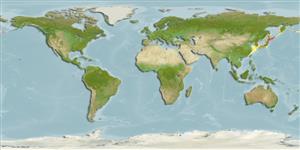Environment: milieu / climate zone / depth range / distribution range
Écologie
marin démersal; profondeur 0 - 90 m (Ref. 56557), usually 0 - 10 m (Ref. 56557). Temperate
Northwest Pacific: Aomori Prefecture, Japan to the southern Kuril Islands and the northern Sea of Japan (Ref. 559); including Okhotsk Sea at northern Sakhalin (Ref. 51666).
Taille / Poids / Âge
Maturity: Lm ? range ? - ? cm
Max length : 25.0 cm SL mâle / non sexé; (Ref. 559); common length : 11.5 cm TL mâle / non sexé; (Ref. 56557)
Occurs near shore on rocky reefs or silty sand to stone and broken shell bottoms; often among algae to depth of 90 meters (Ref. 51666).
Life cycle and mating behavior
Maturité | Reproduction | Frai | Œufs | Fécondité | Larves
Masuda, H., K. Amaoka, C. Araga, T. Uyeno and T. Yoshino, 1984. The fishes of the Japanese Archipelago. Vol. 1. Tokai University Press, Tokyo, Japan. 437 p. (text). (Ref. 559)
Statut dans la liste rouge de l'IUCN (Ref. 130435)
Menace pour l'homme
Harmless
Utilisations par l'homme
Plus d'informations
Noms communsSynonymesMétabolismePrédateursÉcotoxicologieReproductionMaturitéFraiRassemblement de ponteFéconditéŒufsDéveloppement de l'œuf
Taille/Âge
Croissance
Longueur-poids
Longueur-longueur
Fréquences de longueurs
Morphométrie
Morphologie
Larves
Dynamique des populations larvaires
Recrutement
Abondance
BRUVS
RéférencesAquacultureProfil d'aquacultureSouchesGénétiqueElectrophoresesHéritabilitéPathologiesTraitementNutrientsMass conversion
CollaborateursImagesStamps, Coins Misc.SonsCiguateraVitesseType de nageSurface branchialeOtolithesCerveauxVision
Outils
Articles particuliers
Télécharger en XML
Sources Internet
Estimates based on models
Preferred temperature (Ref.
123201): 4.6 - 17.9, mean 8.3 °C (based on 229 cells).
Phylogenetic diversity index (Ref.
82804): PD
50 = 0.6250 [Uniqueness, from 0.5 = low to 2.0 = high].
Bayesian length-weight: a=0.00380 (0.00165 - 0.00876), b=3.16 (2.96 - 3.36), in cm total length, based on LWR estimates for this (Sub)family-body shape (Ref.
93245).
Niveau trophique (Ref.
69278): 3.2 ±0.45 se; based on food items.
Résilience (Ref.
120179): Faible, temps minimum de doublement de population : 4,5 à 14 années (Preliminary K or Fecundity.).
Fishing Vulnerability (Ref.
59153): Low vulnerability (21 of 100).
